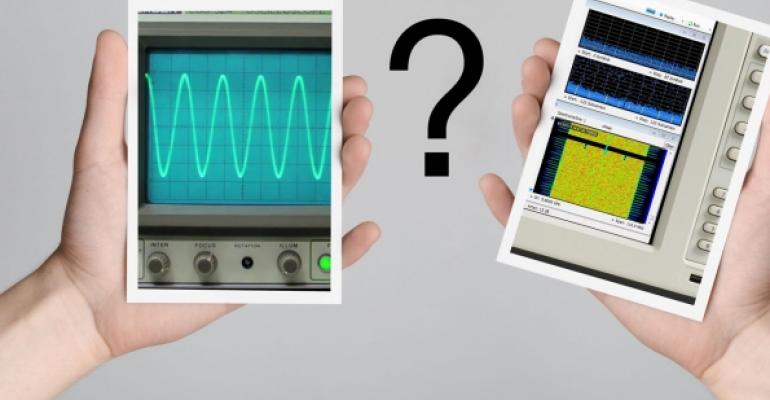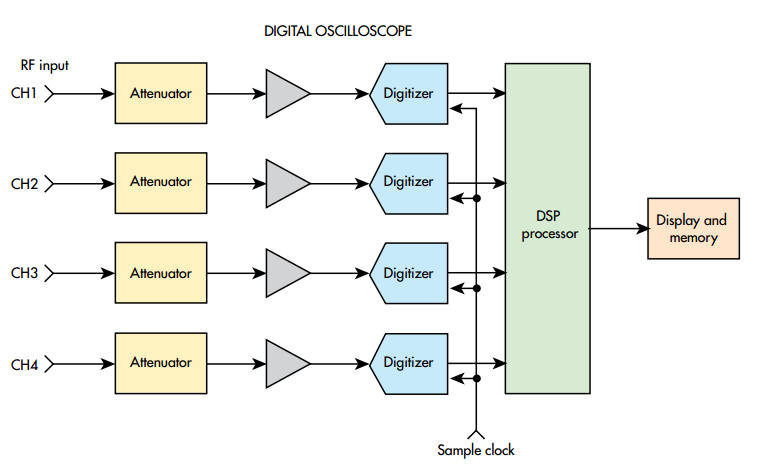News
WHAT’S THE DIFFERENCE BETWEEN SIGNAL ANALYZERS AND OSCILLOSCOPES FOR FREQUENCY ANALYSIS?
The signal analyzer is a spectrum analyzer that includes digital signal processing (DSP). The digital oscilloscope also has added DSP, and gains much higher bandwidths. Their differences in the context of frequency analysis derive from their front-end, signal-conversion approach.
Advances in processing and bandwidth for signal analyzers and oscilloscopes, respectively, make them seem interchangeable for frequency-domain analysis, but that’s not necessarily the case.

The analysis of RF and microwave signals in the frequency domain used to be the forte of the spectrum analyzer, but now it’s become a choice between signal analyzers and digital oscilloscopes. How did this happen? What’s the difference? How how do we choose? Let’s take a look.
Signal analyzers are really spectrum analyzers with digital signal processing (DSP) added to perform functions such as fast Fourier transforms (FFTs). Historically, digital oscilloscopes would not have been a good option for spectrum analysis because their bandwidths were too limited. Now digital scope bandwidths reach into the 100 GHz range. Combined with DSP, they have turned into very useful tools for frequency domain analysis.
Both signal analyzers and digital oscilloscopes offer slightly different advantages. Therefore, a little study is needed in order to pick the best match for a given application.
The core of spectral analysis in both instruments is modern DSP, especially the use of the FFT to efficiently convert sampled time domain data into a frequency spectrum display. The FFT can output spectral data as real/imaginary, or amplitude/phase formats, retaining phase information for further modulation analysis. The physical differences in these instruments can be seen in their functional block diagrams (see figure).
Dissecting the Differences:
The signal analyzer is really a modern version of the older swept spectrum analyzer. The input RF signal is down converted to a lower intermediate frequency (IF). Instead of an analog, variable bandwidth filter used in a traditional RF spectrum analyzer, a digitizer converts the analog IF signal into a digital signal. Now DSP algorithms, including the FFT, can be applied.
One key difference separates the traditional swept spectrum analyzer from the newer signal analyzer: The signal analyzer can fix the local oscillator (LO) frequency and perform a time signal capture and spectrum analysis at that fixed center frequency. The local oscillator determines the center frequency and the sampling clock, along with the related bandpass filter bandwidth, and determines the bandwidth or span of the spectrum display.
In contrast to signal analyzers, the digital oscilloscope digitizes the RF signal directly. The resulting baseband spectrum is anchored at zero hertz (dc) and extends to the oscilloscope bandwidth, which is also related to its sample rate. As mentioned, oscilloscope bandwidth has greatly increased, up to 100 GHz.
Another obvious difference is that the digital oscilloscope can handle more than one channel. Digital oscilloscopes generally offer two, four, or eight channels, with synchronous triggering and sampling. This makes the digital oscilloscope a better choice for multiple-input, multiple-output (MIMO) applications.
A not-so-obvious difference is that the signal analyzer, because it downconverts the signals to a lower intermediate frequency, can digitize with a higher resolution analog to digital converter (ADC). Wide-bandwidth digital oscilloscopes most commonly use 8 bit ADCs. Some lower bandwidth scopes offer 10 or 12 bits. Either way, it’s a tradeoff between bandwidth and dynamic range. The signal analyzer, on other hand, usually offers 14 or 16 bit ADCs, which provides a much higher dynamic range.


The narrower analysis bandwidth of the signal analyzer also results in a lower noise floor. This makes the signal analyzer a better choice for hunting low-level signals over a wide range of frequencies.
When viewing time domain signals, the wider bandwidth of the digital oscilloscope allows it to more accurately measure the signal transition times. A typical signal analyzer can render rise or fall times on the order of 20 ps, but a 100 GHz digital oscilloscope is able to extract transition times as low as 3.5 ps.
In summary, the digital oscilloscope offers wider bandwidth analysis and multiple channels, compared to the higher dynamic range and lower noise floor of the signal analyzer. The signal analyzer typically has a bandwidth of a few hundred megahertz around the center frequency.
The measurement bandwidth will determine the cost of the instrument. At higher bandwidths (>10 GHz), the digital oscilloscope will be more expensive. However, at low-to-moderate bandwidths, it may be less costly than a signal analyzer. Also, for many applications, like radar, a high dynamic range may not be required, so keep that in mind, too.
Source: RSI
Others
- TECOTEC GROUP ATTENDED SHIMADZU’S SERVICE MANAGER MEETING IN 2022
- TECOTEC HANDED OVER EDX-7000 X-RAY FLOURESCENCE SPECTROMETER AT NIDEC CHAUN CHOUNG VIETNAM
- INSTALLATION OF CHIP PROCESSING SYSTEM – LANNER/ GERMANY
- TECOTEC completed installation of EDX-LE Energy dispersive X-ray Fluorescence spectrometer at DYT Vina
- TECOTEC DELIVERED AND INSTALLED THE 2ND X-RAY FLUORESCENCE SPECTROMETER - EDX-LE PLUS AT TABUCHI
- TECOTEC Group has handed over PDA-7000 Optical Emissions Spectrometers for Nihon Plast Vietnam
- Bowman XRF Coating Measurement System For Electroless Nickel Plating
- TECOTEC DELIVERED AND INSTALLED SMX-2000 SYSTEM TO NIDEC TECHNO MOTOR VIETNAM



